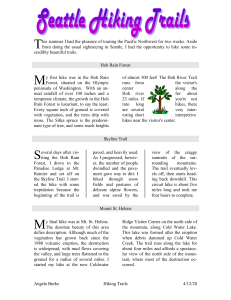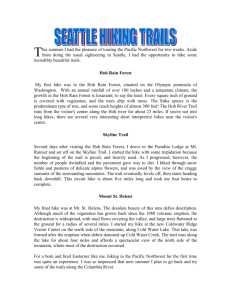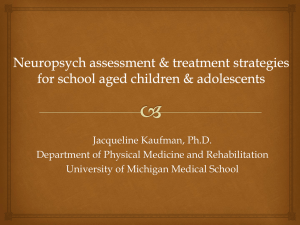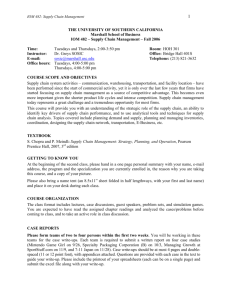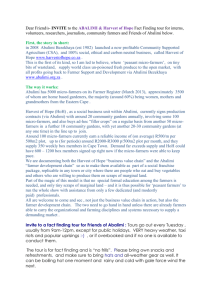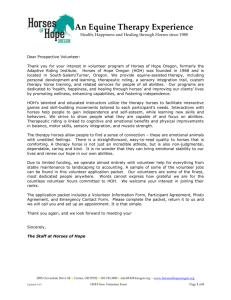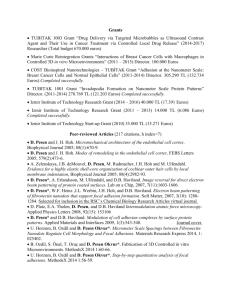Research Project Outline Anniina Lavikainen (WORD)
advertisement
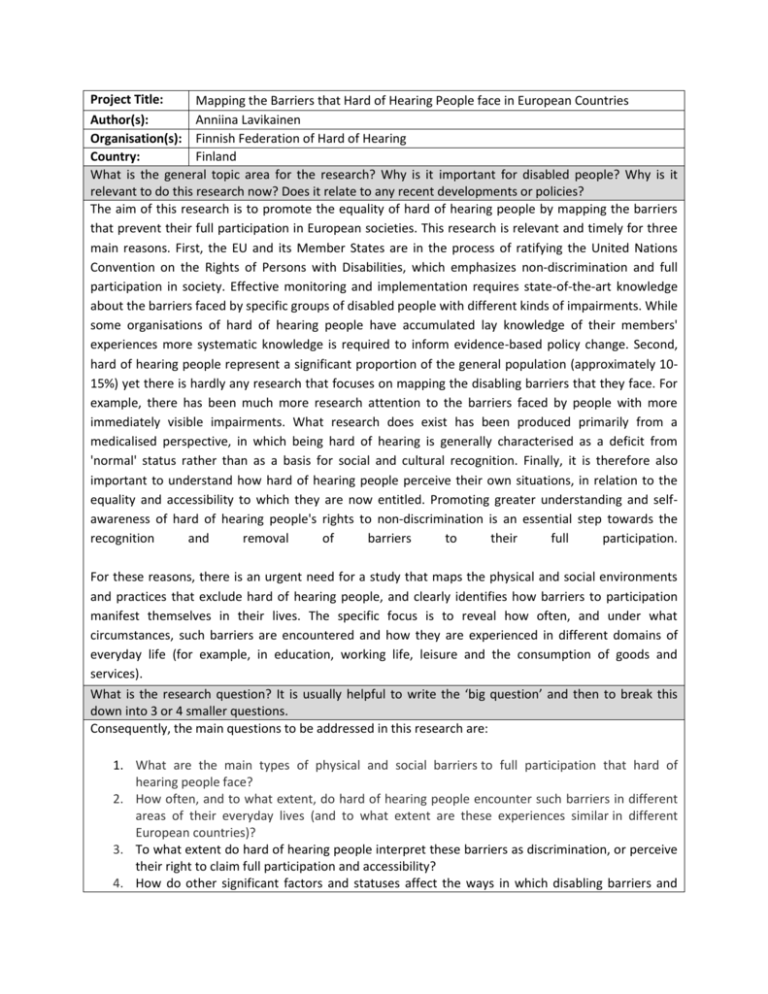
Project Title: Mapping the Barriers that Hard of Hearing People face in European Countries Author(s): Anniina Lavikainen Organisation(s): Finnish Federation of Hard of Hearing Country: Finland What is the general topic area for the research? Why is it important for disabled people? Why is it relevant to do this research now? Does it relate to any recent developments or policies? The aim of this research is to promote the equality of hard of hearing people by mapping the barriers that prevent their full participation in European societies. This research is relevant and timely for three main reasons. First, the EU and its Member States are in the process of ratifying the United Nations Convention on the Rights of Persons with Disabilities, which emphasizes non-discrimination and full participation in society. Effective monitoring and implementation requires state-of-the-art knowledge about the barriers faced by specific groups of disabled people with different kinds of impairments. While some organisations of hard of hearing people have accumulated lay knowledge of their members' experiences more systematic knowledge is required to inform evidence-based policy change. Second, hard of hearing people represent a significant proportion of the general population (approximately 1015%) yet there is hardly any research that focuses on mapping the disabling barriers that they face. For example, there has been much more research attention to the barriers faced by people with more immediately visible impairments. What research does exist has been produced primarily from a medicalised perspective, in which being hard of hearing is generally characterised as a deficit from 'normal' status rather than as a basis for social and cultural recognition. Finally, it is therefore also important to understand how hard of hearing people perceive their own situations, in relation to the equality and accessibility to which they are now entitled. Promoting greater understanding and selfawareness of hard of hearing people's rights to non-discrimination is an essential step towards the recognition and removal of barriers to their full participation. For these reasons, there is an urgent need for a study that maps the physical and social environments and practices that exclude hard of hearing people, and clearly identifies how barriers to participation manifest themselves in their lives. The specific focus is to reveal how often, and under what circumstances, such barriers are encountered and how they are experienced in different domains of everyday life (for example, in education, working life, leisure and the consumption of goods and services). What is the research question? It is usually helpful to write the ‘big question’ and then to break this down into 3 or 4 smaller questions. Consequently, the main questions to be addressed in this research are: 1. What are the main types of physical and social barriers to full participation that hard of hearing people face? 2. How often, and to what extent, do hard of hearing people encounter such barriers in different areas of their everyday lives (and to what extent are these experiences similar in different European countries)? 3. To what extent do hard of hearing people interpret these barriers as discrimination, or perceive their right to claim full participation and accessibility? 4. How do other significant factors and statuses affect the ways in which disabling barriers and rights are experienced by hard of hearing people(such as length of impairment, Deaf identity, gender or age)? 5. What are the priorities for change in policy and practice to remove barriers and create accessibility for hard of hearing people in Europe? What kind of data (new information and knowledge) is needed to answer this question? Do we need statistics or experiences or practical examples? We need both quantitative and qualitative data. We need statistics that tell us how often HOH people face barriers? Statistical data can also answer, for example, if HOH women face barriers more often then HOH men? One aim of the reserach is to identify HOH sub groups who may be more prone to face discrimination. However, statistics do not tell what kind of significance these barriers have in HOH people’s lives. So we need also qualitative descriptions, how these barriers manifest themselves in the lives of HOH. What kind of meaning these barriers have in HOH people’s lives? What methods could we use to get this data? Do we need to analyse documents, conduct a survey, or interviews, or case studies? Are there any new methods that would be useful? Methodological approach in the research project would be based on ideas of participatory/emancipatory disability research. Data would be collected in several phases. At first phase, there would be an adequate number of focus group interviews (different HOH groups included). In focus groups HOH people could freely discuss the barriers they have faced in their lives. The idea of focus groups would be that researcher would not define or decide him/herself what kind of barriers HOH people might face. Following the principles of participatory research it is really important that HOH people define the barriers they face themselves based on their own experiences and points of view and not those of researcher(s). Based on the findings from the focus groups, a survey questionnaire would be developed and showed to the participants of the focus groups for feedback. After the feedback, the survey questionnaire would be finalized and sent to adequate number of HOH people. After receiving the survey answers, data would be analyzed. Based on the survey findings, a typology of barriers (interview frame) would be created for individual interviews. Then at a third phase there would also be a sufficient number of individual qualitative interviews with HOH people. The purpose of the individual interviews would be to gain more knowledge what kind of meaning these different barriers have in HOH people’s lives. In the individual interviews, interviewees could use the interview frame or typology as a base of telling about their experiences. However, they could also add other view points to their stories. Individual interviews would be organized so that there would be room for an interviewee to tell about his or her experiences in a narrative form. In relation to accountability, a research advisory group of HOH people would be established. The advisory group would comment on the research process regularly. The meetings of research advisory group would also offer a place for a constant dialogue between HOH people and researchers. Where will we find the data? Who should we ask? How many people or examples should we look at? In which countries? It would be interesting and necessary to conduct the research in different European countries with different policy traditions as to get a better picture HOH people’s lives in different European societies. For example, the research could be conducted in Finland, UK, Germany and Italy. Essential players in the research project are HOH organizations. The information is needed from HOH people themselves and not for example service-providers for HOH. Because HOH people are so diverse group it is justifiable that the research would be conducted on selected sample. However, the selected sample is not representative of whole population but is purposeful sample that can highlight the specific issues the research project wants to find out. Purposeful sample would include, for example, certain percentage of people with life-long hearing impairment and certain percentage of people with acquired hearing impairment. The purposeful sample would also include equal proportion of men and women and also HOH people of different age. The purposeful sample would also include certain percentage of HOH people who use sign language or other manual methods. Who should be involved in the project and what can they contribute? Which organisations? Would it be useful to involve one or more Universities? Are there any businesses or NGOs or government agencies that should be involved as partners? Both HOH organizations and universities should be involved in the research project. HOH organizations can contribute with their access to HOH people. However, there might be some challenges to reach certain HOH people’s subgroups in all countries. One university should be involved in each country to help in the research process and also to give credibility to the research project. Universities could also contribute with their research knowledge and resources. What will we do with the results of the research? How will we communicate the findings at the end of the project? Do we need a conference, a project website, a report, a book…? Dissemination of the results to HOH people, and the use of research results to empower HOH people to be more aware of their rights. The dissemination of the results also to government officials, academic world, Design for All -network, other related networks. There would be an awareness raising campaign after finding out the results on how to make physical, cultural and social environments and practices fully accessible to HOH people. One objective of the research project would also be identifying the best practices and forwarding them to different levels of society. The research project would produce a practical guide to HOH people including, for example information on what to do in a discriminatory situation.
